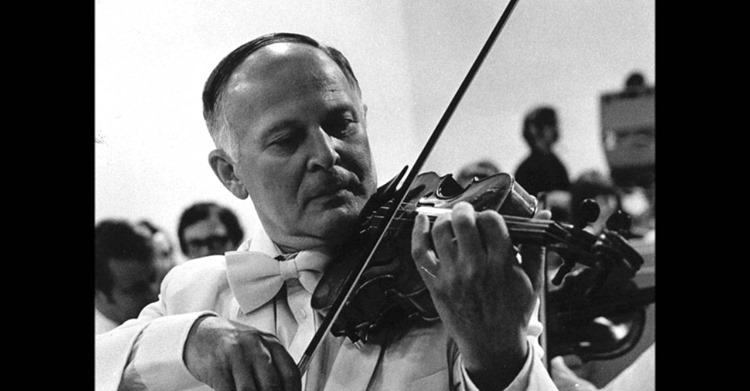
Hartmann, Karl Amadeus, deutscher Komponist, * 2. 8. 1905 München, † 5. 12. 1963 München; Schüler von H. Scherchen, der ihn zu seiner Oper „Simplicius Simplicissimus“ (1934/35 als Protest gegen das Naziregime) anregte, und von A. Webern; im expressionistischen Pathos A. Berg verwandt; schrieb Orchesterwerke (bedeutende Sinfonien), Kammer- und Chormusik.
Karl Amadeus Hartmann (2 August 1905 — 5 December 1963) was a German composer. Some have lauded him as the greatest German symphonist of the 20th century, although he is now largely overlooked, particularly in English-speaking countries. Born in Munich, the son of Friedrich Richard Hartmann, well known there for his flower paintings, and the youngest of four brothers of whom the elder three also became painters, Hartmann was himself torn, early in his career, between music and the visual arts. He was much affected in his early political development by the events of the unsuccessful Workers’ Revolution in Bavaria that followed the collapse of the German monarchy at the end of World War I (see Bavarian Soviet Republic), and he remained an idealistic socialist all his life. He studied composition at the Munich Academy in the 1920s with Joseph Haas, a pupil of Max Reger, and later he received enormous intellectual stimulus and encouragement from the conductor Hermann Scherchen, an ally of the Schoenberg school, with whom he had a nearly lifelong mentor-protégé relationship. He voluntarily withdrew completely from musical life in Germany during the Nazi era, while remaining in Germany, and refused to allow his works to be played there. An early symphonic poem, Miserae (1933–1934, first performed in Prague, 1935) was condemned by the Nazi regime; but his work continued to be performed, and his fame grew, abroad. After the fall of Hitler, Hartmann was one of the few prominent surviving anti-fascists in Bavaria whom the postwar Allied administration could appoint to a position of responsibility. In 1945, he became a Dramaturg at the Bavarian State Opera and there, as one of the few internationally-recognized figures who had survived untainted by any collaboration with the Nazi regime, he became a vital figure in the rebuilding of (West) German musical life. Perhaps his most notable achievement was the Musica Viva concert series which he founded and ran for the rest of his life in Munich. Beginning in November 1945, the concerts reintroduced the German public to 20th-century repertoire which had been banned since 1933 under National Socialist aesthetic policy. Hartmann also provided a platform for the music of the young composers who came to the fore in the late 1940s and early 1950s, helping to establish such figures as Hans Werner Henze, Luigi Nono, Luigi Dallapiccola, Carl Orff, Iannis Xenakis, Olivier Messiaen, Luciano Berio, Bernd Alois Zimmermann and many others. Hartmann also involved sculptors and artists such as Jean Cocteau, Le Corbusier, and Joan Miró in exhibitions at Musica Viva. As a composer, Hartmann attempted a difficult synthesis of many different idioms, including musical Expressionism and jazz stylization, into organic symphonic forms in the tradition of Bruckner and Mahler. His early works contain music that is both satirical and politically engaged. But he admired the polyphonic mastery of J.S. Bach, the profound expressive irony of Mahler, the neoclassicism of Igor Stravinsky and Paul Hindemith. He, also in the 1930s, developed close ties with Béla Bartók and Zoltán Kodály in Hungary, and this is reflected in his own music to some extent. In the 1940s, he began to take an interest in Schoenbergian Twelve-tone technique; though he studied with Webern his own idiom was closer to Alban Berg. In the 1950s, started to explore the metrical techniques pioneered by Boris Blacher and Elliott Carter. He especially makes use of the forms of three-part Adagio slow movements, Fugue, Variations and Toccata.

